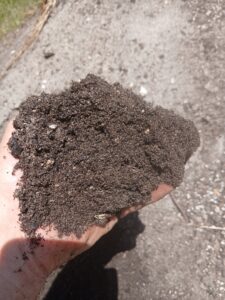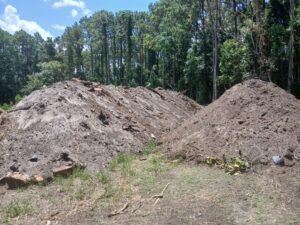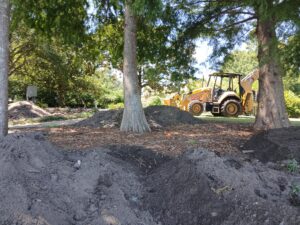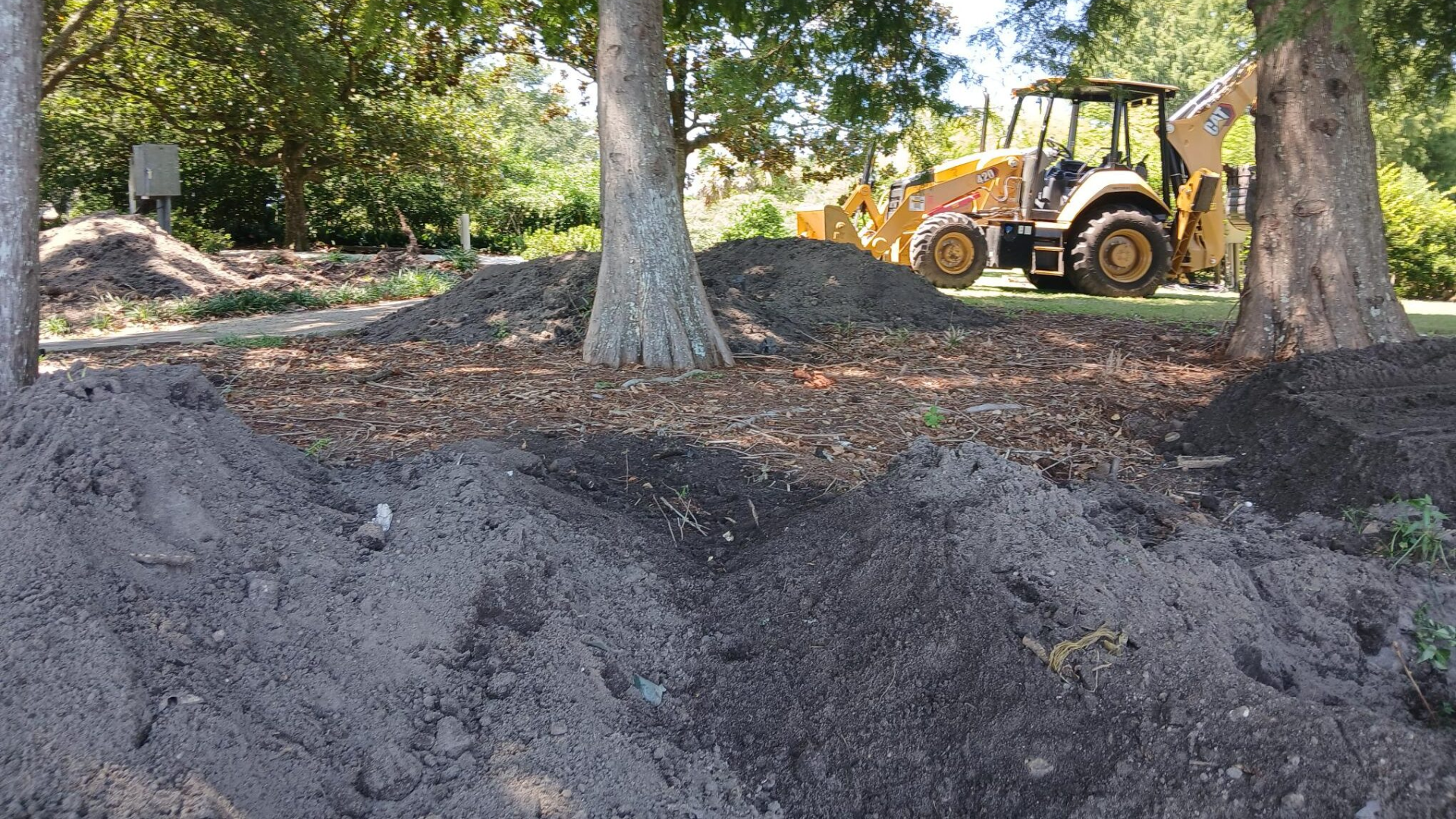Compost, like butter in our favorite recipes, is not to be used sparingly! Nearly every plant we grow in the garden benefits from decomposed organic matter—and often for reasons that we may not think about right away. Bellingrath Gardens is building and processing thousands of cubic yards of rich black gold for use in our seasonal and permanent planting beds.

There are three basic categories of soil: clay (teeny tiny soil particles), loam (medium soil particles), and sand (beach ball-sized particles in comparison to clay and loam). In south Mobile County, our soil is almost entirely made of beach balls (sand). There’s brown sand, white sand, red sand—every color of sand. Even local “topsoil” is sand. I’m amazed at all the iconic plants that are native right here in our native soil. Massive live oaks, towering longleaf pines, palms, grasses, carnivorous plants, and more wildflowers than I can count are all standard botanical fixtures of south Alabama. Some growing in our cultivated acreage, and others in the periphery, hundreds of sand-loving species are currently rooted into Bellingrath’s 900 acres. However, in Bellingrath’s cultivated beds, we are proud to carry on Walter and Bessie’s excitement to showcase for you an even broader representation of the plant kingdom—as well as impossibly concentrated combinations of seasonal color and texture. And that’s where compost enters the picture.
Sometime in the past, an immense amount of compost-rich soil was hauled onsite to create Bellingrath Gardens’ extensive seasonal planting beds; and everywhere you see bedding plants, the soil is primarily made up of composted organic matter. Why go to all the trouble to add so much compost? Let’s get philosophical for a moment. Compost means to plants what the reading of a wealthy uncle’s last will and testament means to a very fortunate nephew. Compost is the posthumous result of plants that found success in their lives—and it is this inheritance that gives future generations of plants a head start and a promising future. I guess that’s why we gardeners get so excited to cultivate plants in our compost “rich” soil.
Ok. Fine. But what does compost actually do as a soil amendment? So glad you asked. Sand, like every type of soil, has its pro’s and con’s. While sand is well drained and not prone to compaction, it can dry out too quickly, lacks certain nutrients, and is prone to leaching out what few nutrients it does offer. There are so many reasons compost is absolutely critical to success in the garden, but since Bellingrath Gardens’ plants are rooted into sandy soil, let’s focus on three ways compost atones specifically for sand’s limitations: through moisture retention, nutrient retention, and cation exchange capacity.
Cation exchange capacity, or CEC, is a measure of the soil’s ability to feed plants through the exchange of positively charged particles—called cations (pronounced cat-ions)—some of the most crucial and frequent exchanges involve the cations calcium, magnesium, potassium, and ammonium. In a nutshell, the higher a soil’s CEC, the more chairs there are at the dinner table where soil is feeding plants. More chairs means more feeding! Mobile County’s sand has a very low CEC (1-5) compared to fine-textured soil like clay and loam (15-30). Get this… compost has a CEC of over 100!!! Jackpot! Many aesthetically supercharged garden plants, especially bedding plants, are very hungry indeed (with a small handful of notable exceptions); and in order to grow them and display them to the highest standards, a whole bunch of cations need to be exchanged along they way.
Most granted wishes come with some sort of an unforeseen catch, hence the phrase “Be careful what you wish for.” In 2023, I remember discovering the annual precipitation in Mobile—67 inches—are you kidding me!? Nothing will ever need irrigation! My wish was granted! The catch? No matter how much rain we get, the sandy soil dries out less than a week! As someone who now gardens on south Alabama sand, I have tempered my initial exuberance. Guess what? Compost is the answer! Actually, compost is possibly the answer to all of life’s problems. Organic matter increases the field capacity of sand… basically, that means sand with compost holds on to more water than just sand. Field capacity was explained to me like this: Think of a sponge that is totally soaked, but no longer dripping. If one drop of water goes in, one drop of water falls out—this sponge is at field capacity. Increased field capacity means more drops of water can stay in that sponge… and maybe we can make it to the next rain before we have to irrigate again. As an aside, when soil dries out, the uptake of nutrients slows down even before the plant begins to wilt—another reason that most well-watered garden plants grow better. Compost-rich soil is a wish-come-true.
We often think of compost as being a form of plant food, but if that’s all organic matter is good for, couldn’t we just throw a bag of 10-10-10 on our plants instead? Ha! Funny. In addition to containing most of the 17 essential nutrients for plant growth (waaay more than just the three numbers on a bag of salt-based fertilizer), compost also helps sandy soil hold on to certain nutrients, like nitrogen, that are typically prone to leaching out of the rootzone. Actually, salt-based fertilizers can make the leaching problem worse over time, but that’s a good topic for another day. Compost’s benefit to the stability of soil fertility is interconnected with its positive impact on CEC and moisture retention.
But nothing good lasts forever—and compost—compost doesn’t last forever. Plants and microbes consume it over time, and eventually it mostly “evaporates” into the atmosphere as carbon dioxide and other gasses. And that brings us back to my opening analogy—butter as an ingredient in our favorite recipes: we need a lot of it, we probably can’t add too much, and it will never be enough.
In order to recharge our seasonal planting beds, and in pursuit of our goal to vastly expand our cultivated areas and living collections, we are piling up, turning, and processing over 10,000 cubic yards of compost onsite to add to the garden (it’s actually closer to 25,000 yards, but I kept the number low to make it sound believable).

I quickly learned that commercial sources for bulk compost are scarce in lower Alabama, as large-scale composting programs are not as prevalent as in other parts of the country. Well, I can’t complain, because we weren’t actively composting our organic matter either. All our nursery and garden debris was just being dumped and forgotten in the back of Bellingrath Gardens…for decades! Let’s just say we are now making full use of this immensely backlogged resource. Because it’s already aged, we will only need to turn it a couple times to incorporate enough oxygen for the final stages of aerobic decomposition. But we’ll have to turn those piles a couple more times again to kill weed seed and rhizomes—turns out weeds like growing in compost just as much as other plants! Oh well! Compost happens. Better late than never.
Utilizing our in-house compost blend, our bed rejuvenation and expansion campaign has already begun. Watch for these efforts to really ramp up in the next couple years as we finish more and more compost.

And as you feast your eyes on Bellingrath Gardens’ beautiful vistas, remember that all of our favorite southern garden recipes go heavy on the compost. We could cook up something without all that rich black gold, but it just wouldn’t be as delicious.
Tune in next time for another Bellingrath Gardens episode of “As the Compost Turns.”


